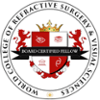Exploring the Different Types of Refractive Surgery

For hundreds of years, glasses offered not only the best but also the only solution to common refractive errors such as myopia (short-sightedness), hyperopia (long-sightedness), and astigmatism. But as technology has developed over the years, more options have become available, including various types of refractive surgery.
While Laser Eye Surgery may be the most well-known type of refractive surgery, it is far from the only option when it comes to vision correction. In this article, we’re taking a closer look at the different types of refractive surgery, from monovision to clear lens exchange (CLE) and how they work to correct refractive errors.
Laser Eye Surgery and the Alternative Treatments
Laser Eye Surgery has been around for decades and, in that time, has successfully treated the refractive errors of tens of millions of people around the world. In recent years, this life-changing treatment has become more accessible than ever before. So, how does it work?
Like glasses and contact lenses, Laser Eye Surgery aims to change the way light is directed into the eye, allowing it to be focused more effectively on the cornea. However, unlike external visual aids, Laser Eye Surgery achieves this by changing the shape of the eye itself.
Ultra-precise lasers are used to remove a specific area of corneal tissue. This tissue is then drawn out of the eye, and the healing process begins. Laser Eye Surgery recovery can vary significantly depending on the type of procedure performed. For example, ablation procedures like PRK and LASEK have the longest healing times, while LASIK and ReLEx SMILE offer faster recovery rates.
Improved technology and cutting-edge techniques mean that Laser Eye Surgery can now correct the vast majority of prescriptions. However, it may not be the best option for all prospective patients. So, let’s take a look at the other types of refractive surgery.
Refractive Lens Exchange (RLE) / Clear Lens Extraction (CLE)
Also known as lens replacement surgery, Clear lens exchange involves replacing the eyes’ natural lenses with artificial intraocular lenses (IOLs). Once the natural crystalline lens is removed from a capsular bag in the eye, the IOL is placed inside. This is the same technique used in Cataract Surgery.
This IOL is specifically selected to treat the exact prescription of each patient. It works in the same way as a typical external contact lens, by correcting the way light is refracted onto the retina at the back of the eye. As such, CLE can correct short-sightedness, long-sightedness, and astigmatism.
The major benefit of this treatment is that it can be used to correct virtually any prescription. Other benefits include:
- Removing the risk of developing cataracts (a condition that causes the natural lenses to become cloudy).
- It can also correct the signs of presbyopia (ageing eyes) as near vision begins to deteriorate (typically over the age of 40).
- It is often suitable for patients who are not candidates for Laser Eye Surgery.
- The lens is designed to be permanently fixed in the eye, so most patients do not require additional procedures.
Phakic IOL Implantation
Phakic IOL Surgery also involves implanting an artificial lens inside the eye; however, unlike in CLE, this doesn’t require the prior removal of the natural lens. Instead, the IOL is placed in front of the natural lens, behind the cornea, to redirect light into the eye.
Again, the IOLs used in this procedure can be used to correct even very high prescriptions. There are several kinds of IOLs, including iris-claw lenses (the ‘Artisan’ lens) and implantable collamer lenses (ICLs).
For some time, phakic IOL implantation was associated with a slightly increased risk of cataract formation. This was due to decreased flow around the eye’s crystalline lens. However, this risk is significantly decreased with the use of Artisan lenses, which feature a small hole to allow for greater flow of aqueous fluid.
Intracorneal Ring Segments (Intacs)
Intacs is a surgical refractive procedure that is primarily used to treat keratoconus, an eye condition that causes the cornea to thin and bulge out into a cone shape. It can also be used to treat mild short-sightedness.
The procedure involves surgically implanting small, crescent-shaped plastic inserts into the cornea. These inserts are designed to adjust the curvature of the cornea to improve vision. The benefits of Intacs treatment can include:
- Reduced dependence on glasses and contact lenses.
- Improved contact lens fit
- Easily reversible treatment
Conductive Keratoplasty
Conductive keratoplasty (CK) is a treatment that involves using radiofrequency energy to reshape the cornea. It can be used to correct common refractive errors such as long-sightedness and presbyopia (ageing eyes).
In CK, a small probe is used to deliver controlled radiofrequency energy. This shrinks the collagen in the peripheral cornea, causing it to become tighter and increasing its curvature.
Unlike some other refractive treatments, CK does not involve cutting or removing any corneal tissue. As such, the treatment offers quick recovery times and low complication rates. However, the effects of conductive keratoplasty are not permanent, and the effects can diminish over time.
If you’d like to learn more about Laser Eye Surgery or our alternative treatments, get in touch with one of our friendly and knowledgeable clinic coordinators today. Alternatively, Book a Consultation to find out if you could be suitable for treatment.


